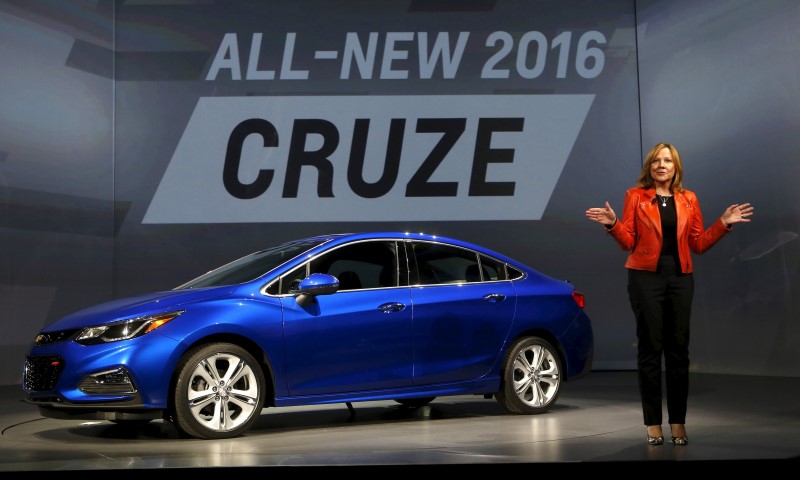By Joseph White and Paul Lienert
DETROIT (Reuters) - General Motors Co (N:GM) executives used to boast about how frequently the company redesigned cars and trucks. Now, the automaker wants to double the lifespan of vehicle platforms as part of a broader effort to slash and redirect capital spending, GM executives said.
Starting with the new Chevrolet Cruze compact, the basic underpinnings of vehicle lines could last a dozen years or more, GM President Dan Ammann told Reuters.
The move underscores the balancing act the automaker faces in tackling conflicting challenges as the growth of auto sales in the U.S. and China slows. GM and its rivals face increasing pressure to prove they can keep core product lines fresh, meet stricter emissions and safety standards, and forge a future in ride-sharing and autonomous vehicles - all while returning more cash to shareholders.
Over the next several years, the company will undertake the most extensive overhaul of its vehicle development process in decades, GM executives said.
The goal is to design its global fleet of vehicles with just a few basic building blocks, spreading the engineering and research costs for a given lineup of cars and SUVs over millions more vehicles.
A single platform, underpinning multiple models, might stay largely same for more than a decade, GM executives said. Global product development chief Mark Reuss said the company aims for up to 2.5 million sales a year from a variety of models built on the same platform as the Cruze compact, including the mechanically similar European Opel Astra.
Exterior styling will change more often, with updates of sheet metal or plastic skins - so-called "top hats" in GM parlance. The automaker also plans to freshen electronic features with software updates delivered over the internet.
The move to fewer and long-lasting platforms poses multiple risks.
GM could end up with platforms that are technologically outdated, analysts cautioned, or not appealing to diverse customers in different global markets. Further, most of GM's rivals are also moving to slash the number of different vehicle platforms they use.
"The advantage could be short-lived," said Jeff Schuster, senior vice president at LMC Automotive, a forecasting company.
SHIFTING SPENDING
Making the company leaner will also require increased spending in the short term.
GM said it plans to initially increase capital spending to about $9 billion a year through 2019, up from $7 billion a year in 2014.
For the period 2016 through 2019, capital spending will rise to between 5 percent and 5.5 percent of revenue, up from 4.4 percent in 2014.
After that, Ammann said, capital spending will fall closer to 2014 levels as a share of revenue, with much of it directed to new priorities. Spending less on dies and welding machines will allow for more investment in developing autonomous vehicles, delivering services through high-speed internet connections in cars, and new businesses such as ride sharing, executives said.
GM earlier this month invested $500 million in ride-hailing company Lyft, and last week it said it was launching car-sharing ventures under the new brand, Maven. On Thursday, GM grouped all its autonomous and electric vehicle engineering under one executive in a move to speed development of those technologies.
The short-term increase in capital spending will pay for projects such as a $1.4 billion overhaul of the Arlington, Texas factory that builds GM's cash cows - large sport utility vehicles such as the Cadillac Escalade.
SKEPTICAL INVESTORS
The increased spending makes it critical for GM Chief Executive Mary Barra to deliver the promised savings over the long term. The company has largely failed over the past three decades to execute previous plans to control engineering costs.
GM executives said longer-lived vehicle designs are just one element of the cost-cutting strategy. Others include longer-term contracts to suppliers that could allow for cheaper parts and using less steel and plastic as engineers shave hundreds of pounds from future models.
The automaker is also launching a $5 billion effort with Shanghai Automotive Industry Corp to engineer a new, low-cost vehicle line for sale in emerging markets. The partnership is the most extensive attempt yet by GM to collaborate with its Chinese partner.
GM has discovered it can build the complex dies used to stamp metal vehicle parts in China for 20 to 40 percent less than it would spend in the U.S. or Europe, Ammann said.
The automaker's overhaul could be a tough sell to investors.
GM shares are down nearly 15 percent since Jan. 1, despite the automaker's record profits and its plans to return $16 billion to shareholders in buybacks and increased dividends from 2015 to 2017. Other automakers' shares are also off sharply, as analysts warn that global auto sales and profits have likely peaked for now.
Intensified competition in a flat market could force automakers to cut prices, potentially nullifying the benefit of any savings from more efficient engineering, said Bernstein analyst Max Warburton.
"The auto industry," he said, "has a proven ability to invest to the point of zero return."
